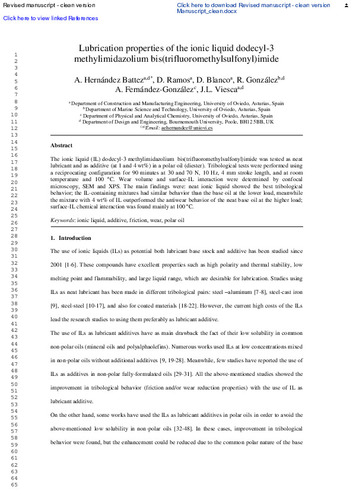Lubrication Properties of the Ionic Liquid Dodecyl-3 Methylimidazolium bis(trifluoromethylsulfonyl)imide
Palabra(s) clave:
Ionic liquid
Additive
Friction
Wear
Polar oil
Fecha de publicación:
Versión del editor:
Citación:
Descripción física:
Resumen:
The ionic liquid (IL) dodecyl-3 methylimidazolium bis(trifluoromethylsulfonyl)imide was tested as neat lubricant and as additive (at 1 and 4 wt%) in a polar oil (diester). Tribological tests were performed using a reciprocating configuration for 90 min at 30 and 70 N, 10 Hz, 4 mm stroke length, and at room temperature and 100 °C. Wear volume and surface–IL interaction were determined by confocal microscopy, SEM, and XPS. The main findings were: Neat ionic liquid showed the best tribological behavior; the IL-containing mixtures had similar behavior than the base oil at the lower load; meanwhile, the mixture with 4 wt% of IL outperformed the antiwear behavior of the neat base oil at the higher load; surface–IL chemical interaction was found mainly at 100 °C.
The ionic liquid (IL) dodecyl-3 methylimidazolium bis(trifluoromethylsulfonyl)imide was tested as neat lubricant and as additive (at 1 and 4 wt%) in a polar oil (diester). Tribological tests were performed using a reciprocating configuration for 90 min at 30 and 70 N, 10 Hz, 4 mm stroke length, and at room temperature and 100 °C. Wear volume and surface–IL interaction were determined by confocal microscopy, SEM, and XPS. The main findings were: Neat ionic liquid showed the best tribological behavior; the IL-containing mixtures had similar behavior than the base oil at the lower load; meanwhile, the mixture with 4 wt% of IL outperformed the antiwear behavior of the neat base oil at the higher load; surface–IL chemical interaction was found mainly at 100 °C.
Patrocinado por:
The authors thank to the Foundation for the Promotion in Asturias of the Applied Scientific Research and Technology (FICYT) and the Ministry of Economy and Competitiveness (Spain) for supporting this work in the framework of the research projects Lubrication and Surface Technology (GRUPIN14-023) and STARLUBE (DPI2013-48348-C2-1-R), respectively. The authors would also like to thank CRODA IBERICA S.A. for kindly providing the base oil used for the development of this research. Finally, the Scientific-Technical Services at the University of Oviedo are also acknowledged.
Colecciones
Ficheros en el ítem




